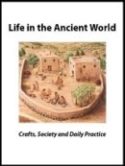
Archaeologists in Thebes have discovered a burial for victims of the 3rd-century C.E. Cyprian Plague. Photo by N. Cijan © Associazione Culturale per lo Studio dell’Egitto e del Sudan ONLUS.
Archaeologists working in Thebes (modern Luxor) in Egypt discovered evidence of a plague that ravaged the Roman Empire in the 3rd century C.E. The so-called Cyprian Plague, likely caused by a form of measles or smallpox, was so devastating that one eyewitness believed the world was coming to an end.
During excavations of the Funerary Complex of Harwa and Akhimenru, the Italian Archaeological Mission to Luxor (MAIL), led by Francesco Tiradritti, uncovered charred human remains saturated in lime. The lime, historically used as a disinfectant, was made in three kilns discovered in the complex. A huge bonfire where the victims were burned was also found. The archaeologists used pottery discovered in the kilns to date the burial to the third century C.E.
Between about 250 and 271 C.E., a plague—now known as the Cyprian Plague—swept across Egypt and the rest of the Roman Empire, reportedly claiming more than 5,000 victims a day in Rome alone. Publishing their findings in Egyptian Archaeology, the MAIL researchers believe they have uncovered the burial site of the Theban plague victims.
“We found evidence of corpses either burned or buried inside the lime. They had to dispose of them without losing any time,” Tiradritti told LiveScience.

The modern name for the third-century plague is derived from early Christian writer St. Cyprian, bishop of Carthage (modern Tunisia), who vividly described the pandemic in a series of accounts. St. Cyprian believed that the pestilence signaled the end of the world:
“The kingdom of God, beloved brethren, is beginning to be at hand,” he wrote.
The disposal of the Theban plague victims was conducted in a funerary complex originally built in the seventh century B.C.E. for a steward named Harwa. Harwa’s successor Akhimenru built his own tomb there, and thereafter Egyptians continued to use the complex for burials. The funerary complex was, however, abandoned after the burial of the Cyprian Plague victims.
Read more about the discovery of the Cyprian Plague remains in Luxor in LiveScience.
This Bible History Daily feature was originally published on June 19, 2014.
Related reading in Bible History Daily:
Justinian Plague Linked to the Black Death
Epilepsy, Tutankhamun and Monotheism
4,200-Year-Old Egyptian Skeleton Shows Earliest Evidence of Breast Cancer
The post The Cyprian Plague appeared first on Biblical Archaeology Society.

0 Commentaires